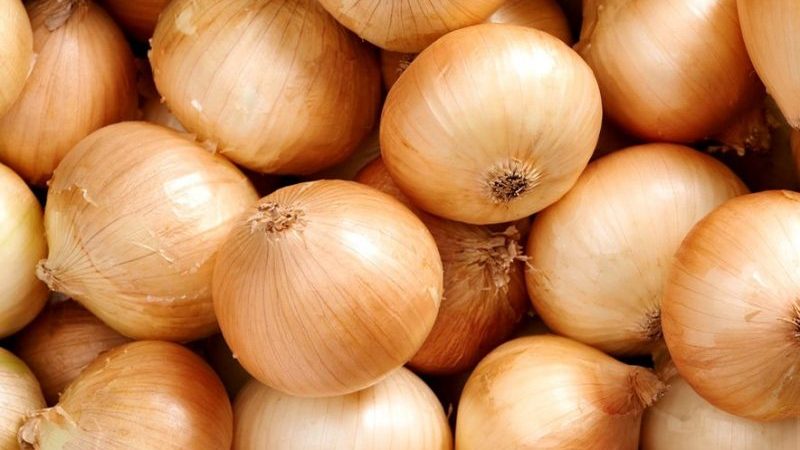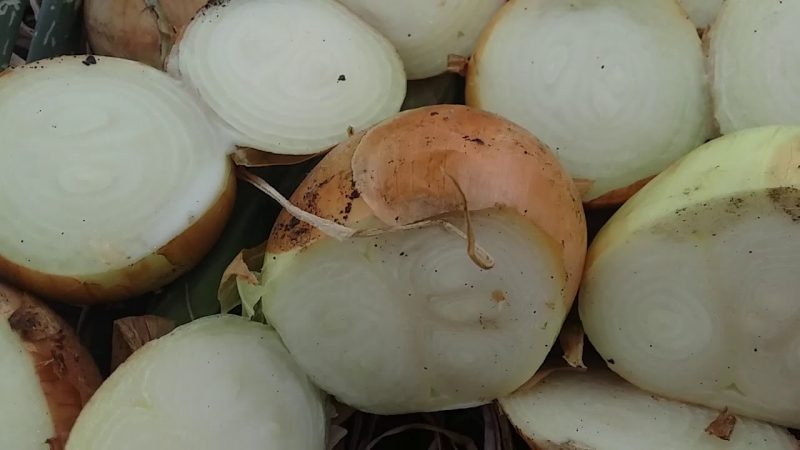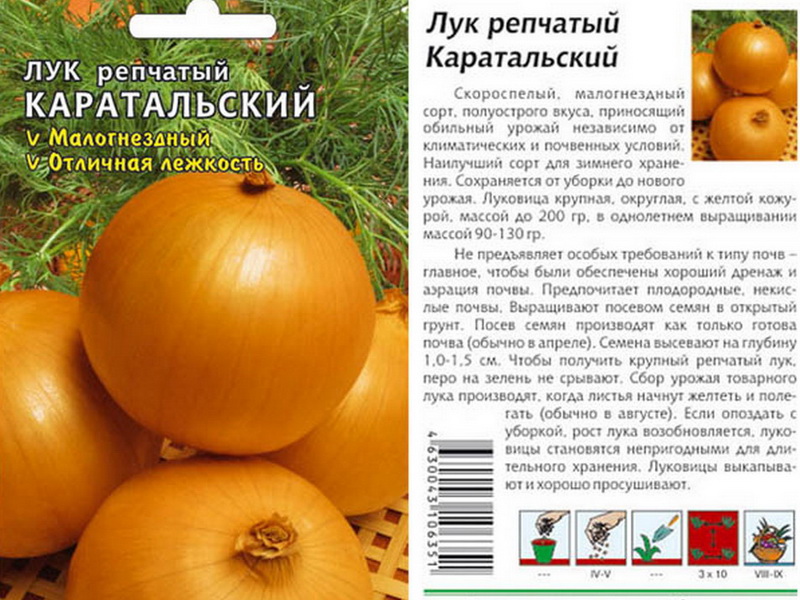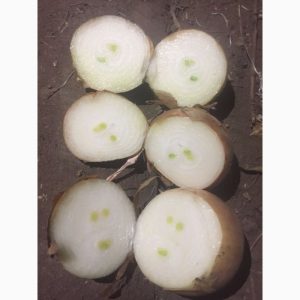The time-tested onion variety "Karatalskiy"
People love and appreciate onions for their beneficial properties and taste for the body. This is one of the most common garden crops. Among the many varieties cultivated in the beds, the Karatal onion stands out, which has been grown in our country for 60 years.
The content of the article
What kind of onion is this
Karatalsky or simply Karatal is one of the oldest varieties of onions in Russia. The culture is early maturing, unpretentious in care, excellent for winter storage.

Origin and development
The Karatalsky variety was bred by breeders of the Kazakh Research Institute of Agriculture in 1955 on the basis of the Johnson variety. In 1959, the culture was included in the list of approved. For over 60 years, Karatal has been chosen for landing both summer residents and agrarians for industrial cultivation.
Distinctive features
Karatalsky has a rounded, sometimes slightly flattened shape of bulbs. Dry scales are golden, juicy - white. Light green feathers are well developed, reaching 30–40 cm.
Vegetables with annual cultivation reach 130 g, from seedlings - about 200 g. The culture gives 3-4 arrows 130-140 cm high. Onion tastes moderately spicy.
Description and characteristics
The variety is early ripening: it takes 95–120 days from the emergence of seedlings to lodging of feathers.
Productivity is high: on average 3-5 kg are harvested per 1 m². Commodity indicators - 200-440 c / ha.

How to grow
The variety's unpretentiousness to air temperature and soil composition makes it easy and cost-effective to grow.
Seeds are planted in open ground with a drainage cover. The soil should be loose and non-acidic: this will allow the bulbs to form better and provide oxygen access to the roots. To increase the yield, before planting, the soil is fertilized with compost or manure: for each 1 m², 5 kg of the agent are applied.
Onions are planted in areas where zucchini, tomatoes, cucumbers, cabbage, pumpkins and legumes used to grow. In the same place, the crop is not grown to avoid rot and other diseases.
Important! Stagnation of water in the soil during the cultivation of Karatal leads to rotting, therefore, drainage is provided in advance.
Terms and rules of landing
Sowing time is calculated based on climatic conditions. The soil must be well warmed up, otherwise the seeds will sit in the soil for a long time. A temperature of + 3 ... + 5 ° C is sufficient. Depending on the region, disembarkation takes place from late March to mid-April.
Even if it is cool in April, onion sowing is not delayed for long. This will result in late ripening and loss of much of the crop. Karatalsky successfully withstands short-term frosts.
For growing onions from seeds before planting they are processed in a weak solution of potassium permanganate during the day, the emerging specimens are removed. After disinfection, it is placed in a damp gauze and removed to a warm place for germination.
Onion planting scheme:
- Seeds are planted at a distance of 10 cm from each other. The groove depth does not exceed 2 cm.
- The row spacing is at least 20 cm.
- To prevent the formation of an air gap between the seeds and the soil, the soil is slightly compacted when buried.
- After sowing, the soil is moistened with warm water.
After the emergence of seedlings, the planting is thinned out, leaving a distance between the shoots of about 2 cm.Repeat the procedure after 2-3 weeks, increasing the distance to 7 cm.
Attention! Do not water the seeds before the first germination: the crust formed from the water will prevent the emergence of sprouts.

Care
The Karatalsky variety is able to do without leaving, but to obtain large juicy bulbs, basic agrotechnical procedures are carried out:
- Culture regularly watered: from late spring to mid-summer, the soil is moistened every 7-9 days, spending 5-6 liters per 1 m2 of plot. In a dry season, the frequency of watering is doubled, up to 10 liters per 1 m2 are used. Irrigation is stopped 3-4 weeks before harvesting.
- The beds are mulched to retain moisture and slow weed growth. If the mulch is organic, then when decomposed, it will enrich the earth with nutrients.
- The soil is periodically loosened after each watering for root ventilation. Weeds are removed as they grow.
- Mineral fertilizers are applied once a month. With the autumn enrichment of the soil with organic matter, the culture is not fed in spring and summer.
The nuances of growing and possible difficulties
There are no difficulties in growing the Karatalsky variety. Unpretentious care makes the plant almost "independent".
It is important to prevent the formation of a crust on the ground and to moisten the plantings in time, especially in dry times. Most often, the variety is grown as an annual crop from seeds, although seedlings are also planted.
Important! To obtain a large harvest, feathers are not cut off.
Diseases and pests
The vegetable is susceptible to fungal diseases and pest attacks. The most dangerous for the variety:
- Powdery mildew - the rate of spread of the fungus makes this disease dangerous for many plants, including the Karatal onion. Dirty yellow streaks on feathers are a clear sign of powdery mildew. The affected areas are treated with "Trichodermin" or "Baktofit".
- Gray rot - destroys onions during storage, affecting the neck of vegetables. As a result, the entire crop rots. In the fight against the disease, only a careful bulkhead and sorting of the harvested bulbs, as well as regular checking of the crop during storage, helps.
- Onion fly - to eliminate the pest, carrots are planted next to the onion garden. Plants are watered with saline at the rate of 300 g of salt per 10 liters.
Collection, storage and use of the crop
Harvest in mid-August. To keep it well and for a long time, they do it on a sunny day. A week after harvesting, vegetables are dried in the open air, periodically turning over, at a temperature not lower than + 25 ° C.
Important! The bulbs are not pulled out of the ground so as not to damage them, but carefully dug out with a pitchfork.
Store the crop in a dark, dry place at a temperature of + 2 ... + 5 ° C.
Karatal is used raw, feathers and bulbs are added to salads. An irreplaceable vegetable for soups, stews, casseroles and many other dishes in cooking around the world. It is also used for conservation.
The time-tested variety Karatalsky has taken a worthy place in folk medicine. Them treat colds and bronchopulmonary diseases, increase immunity, stabilize blood pressure, used as a tonic and diuretic.
Interesting fact. The vegetable is also useful in everyday life: skillful housewives bleach shoes with onion gruel, clean irons from burn marks, and metal objects from rust, add shine to varnished surfaces.
Advantages and disadvantages of the variety
The advantages of onions significantly exceed its disadvantages, which makes the variety a favorite of many gardeners.
Benefits:
- high productivity;
- unpretentiousness to climatic conditions and soils;
- cold resistance;
- excellent presentation of the bulbs;
- semi-sharp taste;
- the possibility of mechanical cleaning;
- high transportability;
- suitability for storage;
- resistance to a number of viral diseases: mosaic, fusarium, yellow dwarfism;
- good keeping quality.
Onions of the Karatalsky variety are susceptible to fungal diseases, susceptible to attacks of onion flies.
For which regions is it suitable
As an annual crop, onions are grown in the Volga region and the Central Black Earth region of Russia.In addition, the variety is successfully cultivated in the near abroad - Uzbekistan, Armenia, Ukraine, Kyrgyzstan and Kazakhstan.
By the way! Karatal is a full-fledged variety, not a hybrid, therefore it is bred from seeds collected on its site.
At the same time, the variety is also suitable for regions with colder climates. To keep within the vegetative cycle, the seedling method of growing is used. To do this, germinated seeds are placed in peat pots at the end of February, and in May the seedlings are dived into open ground.
Farmers reviews
Vegetable growers often respond positively to the variety, but finding the same Karatal today is a problem for many.
Denis Ulyanov, Perm: “There are many rumors, stories, reviews, both negative and positive, about the Karatal onion variety. However, not every farmer has the opportunity to purchase and, accordingly, grow more or less "pure" Karatal, as he has long been "suffering" from overgrading. My personal opinion: if there is at least 60-80% of Karatal in the bag and the rest of the onion matches our turnip at least a little, I advise you to take it. "
Elena, Taganrog: “Yesterday we chose sevok Karatalsky - all different shapes and colors! Horror! I have no words!"
Alina, Shakhty: “In general, the initial goal was to buy the Karatal onion, which I love most and usually buy, but this year there is some problem with it. It is very difficult to find it. So I got another one. "
Conclusion
Despite the abundance of new hybrids and varieties of onions, Karatalsky has been cultivated in gardens and dachas for many years - true connoisseurs are ready to pay twice as much for seeds than for any other variety.
Karatal is high-yielding, practically does not require maintenance, it tolerates frost and major viral diseases. Semi-sharp juicy bulbs are universal in cooking, they are stored for a long time without loss of taste and presentation.